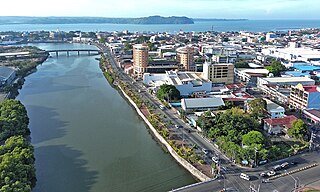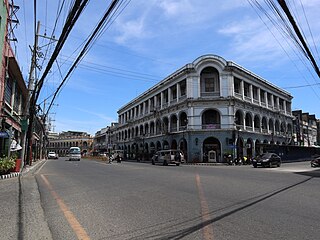
Pototan, is a 1st class municipality in the province of Iloilo, Philippines. According to the 2020 census, it has a population of 78,298 people.

Iloilo City, officially the City of Iloilo, is a 1st class highly urbanized city in the Western Visayas region of the Philippines, located on the southeastern coast of the island of Panay. According to the 2020 census, Iloilo City has a population of 457,626 people, making it the most populous city in Western Visayas. For the metropolitan area, the total population is 1,007,945 people.

Dingle, officially the Municipality of Dingle, is a 3rd class municipality in the province of Iloilo, Philippines. According to the 2020 census, it has a population of 45,965 people.

Jaro is a district in Iloilo City, Philippines, located in Iloilo province, on Panay Island in the Western Visayas region. It is the largest district in terms of both geographical area and population, with 130,700 people according to the 2020 census. It is the seat of the Roman Catholic Archdiocese of Jaro, which encompasses the provinces of Iloilo, Guimaras, Antique, and Negros Occidental, as well as the center of the Candelaria devotion in the Philippines.

The Captaincy General of the Philippines was an administrative district of the Spanish Empire in Southeast Asia governed by a governor-general as a dependency of the Viceroyalty of New Spain based in Mexico City until Mexican independence when it was transferred directly to Madrid.

The Negros Revolution, commemorated and popularly known as the Fifth of November or Negros Day, was a political movement that in 1898 created a government on Negros Island in the Philippines, ending Spanish control of the island and paving the way for a republican government run by the Negrense natives. The newly established Negros Republic lasted for approximately three months. American forces landed on the island unopposed on February 2, 1899, ending the island's independence. Negros was then annexed to the Philippine Islands on 20 April 1901.

The Augustinian Province of Sto. Niño de Cebu, based in Cebu City, Philippines, is a geographical and administrative subdivision of the religious Order of St. Augustine. The Province is actively involved in education, parish administration, mission work and formation of candidates for religious life. It has worked on joint missions with other Augustinian provinces, namely, the Australian Province in South Korea, the Dutch Province in Indonesia, and the Provinces of Villanova, Ireland and England-Scotland in South Africa. In keeping with its goal to become a missionary Province, it has begun sending friars overseas to help in apostolic and pastoral ministries.

Molo is a district in Iloilo City, Philippines, located in the province of Iloilo, on the island of Panay in the Western Visayas region. It is the most densely populated district in the city. According to the 2020 census, Molo has a population of 76,393 people, making it the second-most populous district, after Jaro.

Iloilo City Proper, also known as Downtown Iloilo or simply Iloilo among locals, is an administrative district in Iloilo City, Philippines, located on the southeastern coast of the island of Panay in the Western Visayas region. It serves as the civic center of the city and province of Iloilo, hosting the seat of city and provincial governments, as well as various local, provincial, and regional government offices. According to the 2020 census, it has a population of 46,350 people.
Lacson is a Filipino surname with deep historical roots originating in the provinces of Iloilo and Negros Occidental, and with branches extending to Cavite and Pampanga. They are a prominent family involved in business, politics, real estate, and agriculture. The surname "Lacson" is a transliteration of the Chinese-Spanish name "la̍k-sun," influenced by Spanish orthography. It is derived from the Hokkien language, combining the elements 六 and 孫 which has also been spelled as Laxon and Laczon by the Spaniards.
The Araneta family is a Filipino family that originated from Gipuzkoa, the Basque region of northern Spain. The name is derived from the Basque word aran meaning "valley", with the suffix -eta meaning "abundance of", but also a locative term denoting place. In this case, the Araneta name means "the family that comes from the valley".

Ancestral houses of the Philippines or Heritage Houses are homes owned and preserved by the same family for several generations as part of the Filipino family culture. It corresponds to long tradition by Filipino people of giving reverence for ancestors and elders. Houses could be a simple house to a mansion. The most common ones are the "Bahay na Bato". Some houses of prominent families had become points of interest or museums in their community because of its cultural, architectural or historical significance. These houses that are deemed of significant importance to the Filipino culture are declared Heritage House by the National Historical Commission of the Philippines (NHCP), previously known as the National Historical Institute (NHI) of the Philippines. Preservation is of utmost importance as some ancestral houses have come into danger due to business people who buy old houses in the provinces, dismantle them then sell the parts as ancestral building materials for homeowners wishing to have the ancestral ambiance on their houses. These ancestral houses provide the current generation a look back of the country's colonial past through these old houses.

Plaza de España, also known as Plaza España, is a public square in Intramuros, Manila, Philippines, formed by the intersection of Andres Soriano Avenue, Solana Street and Muralla Street. It is a triangular "square" which features a monument to King Philip II of Spain, after whom the Philippines was named. The square is one of 47 parks and plazas in the City of Manila maintained by the city's Park Development Office in partnership with the Intramuros Administration. It is surrounded by the Aduana Building, the BPI Intramuros building, which replaced the old Santo Domingo Church destroyed during World War II, and the Banco Filipino condominium building built on a portion of the old Ayuntamiento de Manila.

Calle Real, officially named as J.M. Basa Street, is a historic street located in the old downtown district of Iloilo City Proper in Iloilo City, Philippines. It is home to several fine examples of luxury American-era neoclassical, beaux-arts, and art deco buildings. The street has been famous since the Spanish era and once served as the city's main shopping center for more than a century.

The Federal State of the Visayas was a revolutionary state in the Philippine archipelago during the revolutionary period. It was a proposed administrative unit of a Philippines under a federal form of government.

The Old Jaro Municipal Hall is a heritage building which previously served as the seat of government of the former city of Jaro in Iloilo province.

The Governor of Iloilo is the local chief executive of the Philippine province of Iloilo. The governor holds office at the Iloilo Provincial Capitol located at Bonifacio Drive, Iloilo City. Like all local government heads in the Philippines, the governor is elected via popular vote, and may not be elected for a fourth consecutive term. In case of death, resignation or incapacity, the vice governor becomes the governor. Along with the governors of Aklan, Antique, Capiz, andGuimaras, he sits in the Regional Development Council of the Western Visayas Region.

GeronimoPerez Treñas, publicly known as JerryTreñas, is a Filipino politician serving as the mayor of Iloilo City since 2019. He also previously served in that office from 2001 to 2010 and briefly in 1992. Treñas is also the chairman of the Metro Iloilo–Guimaras Economic Development Council (MIGEDC), the government agency responsible for the development of the Metro Iloilo–Guimaras area. He also previously served as the Representative of Iloilo City from 2010 to 2019 and was a member of the Iloilo City Council from 1986 to 1992.
Iloilo Supermart, Inc. is a supermarket chain operating in Metro Iloilo, Philippines. It is the largest homegrown supermarket chain in Western Visayas. The chain operates its anchor stores and other brands that include Paper Chase, Homestore, Tinapayan, Medicine Corner, ISX Superstore, The Atrium at the Capitol, and Right Choice.

















